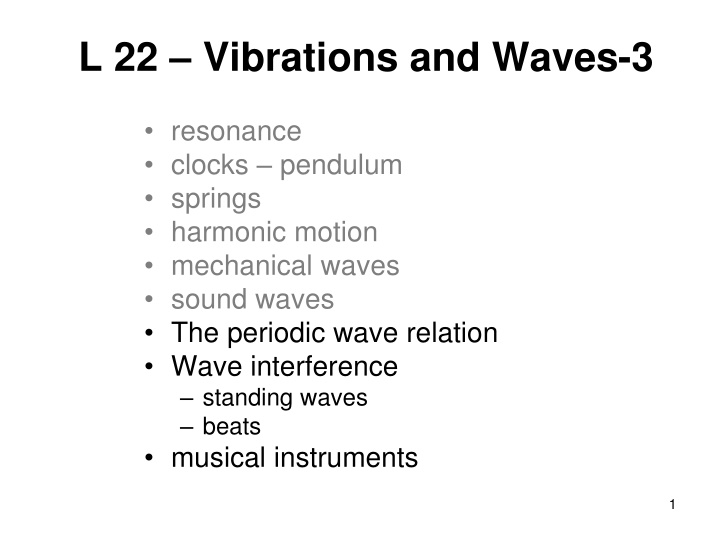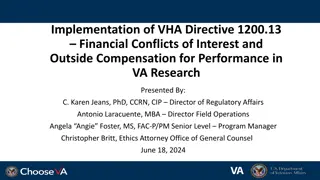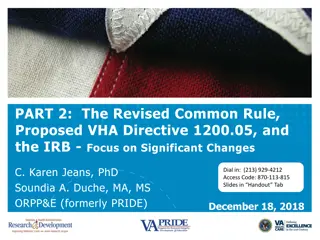
Vibrations, Waves, and Sound
Explore the principles of mechanical waves, wave properties like wavelength and frequency, and how sound waves are generated through longitudinal pressure disturbances. Learn about harmonic motion, wave interference, and the periodic wave relation in this comprehensive overview.
Download Presentation

Please find below an Image/Link to download the presentation.
The content on the website is provided AS IS for your information and personal use only. It may not be sold, licensed, or shared on other websites without obtaining consent from the author. If you encounter any issues during the download, it is possible that the publisher has removed the file from their server.
You are allowed to download the files provided on this website for personal or commercial use, subject to the condition that they are used lawfully. All files are the property of their respective owners.
The content on the website is provided AS IS for your information and personal use only. It may not be sold, licensed, or shared on other websites without obtaining consent from the author.
E N D
Presentation Transcript
L 22 Vibrations and Waves-3 resonance clocks pendulum springs harmonic motion mechanical waves sound waves The periodic wave relation Wave interference standing waves beats musical instruments 1
Review A mechanical wave is a disturbance that travels through a medium solids, liquids or gases it is a vibration that propagates The disturbance moves because of the elastic nature of the material As the disturbance moves, the parts of the material (segment of string, air molecules) execute harmonic motion (move up and down or back and forth) transverse wave--- waves on strings longitudinal wave --- sound 2
Wavelength: ( (lambda) Snapshot of the string at some time freezes the motion Wave crests Wave troughs each segment of the string undergoes simple harmonic motion as the wave passes by distance between successive peaks (wave crests) is called the WAVELENGTH (lambda), it is measured in meters or centimeters 3
Period (T) or Frequency ( f ) An observer at a fixed position observes the wave moving by The time between successive crests passing by (or troughs) is the PERIOD T The number of crests passing by per unit time is the FREQUENCY f Displacement (m) Time (s) T T Period and frequency are inversely related 1 f = T 4
The periodic wave relation The wavelength, period (or frequency) and wave speed are related In one period the wave moves one wavelength, so the wave speed v = /T Since f = 1/T, this can be written as f = v which is the periodic wave relation. 5
Example: wave on a string 2 cm 2 cm 2 cm A wave moves on a string at a speed of 4 cm/s A snapshot of the motion shows that the wavelength, = 2 cm, what is the frequency, ? v = , so = v / = (4 cm/s ) / (2 cm) = 2 Hz T = 1 / f = 1 / (2 Hz) = 0.5 s 6
Making sound waves longitudinal pressure disturbances When the diaphragm in the speaker moves out it compresses the layer of air in front of it. This compressed air layer then expands and pushes on another layer of air adjacent to it A propagating sound wave is produced 7
Tuning forks make sound waves The vibration of the fork causes the air near it to vibrate The length of the fork determines the frequency longer fork lower f shorter fork higher f It produces a pure pitch single frequency 8
Stringed instruments Three types Plucked: guitar, bass, harp, harpsichord Bowed: violin, viola, cello, bass Struck: piano All use strings that are fixed at both ends The speed of the wave on the string depends on: The tension in the string which is adjustable (tuning) The thickness of the string (instruments have some thin and some thicker strings) The periodic wave relation applies: f = v 9
Bowed instruments In violins, violas, cellos and basses, a bow made of horse hair is used to excite the strings into vibration Each of these instruments are successively bigger (longer and heavier strings). The shorter strings make the high frequencies and the long strings make the low frequencies Bowing excites many vibration modes simultaneously includes a mixture of tones (richness) 10
Wind instruments: organs, flutes The air pressure inside the pipe can vibrate, in some places it is high and in other places low Depending on the length of the pipe, various resonant modes are excited, just like blowing across a pop bottle The long pipes make the low notes, the short pipes make the high notes 11
St. Vincents Episcopal Church in Bedford, Texas Gravissima 8.2 Hz 4400 Hz 12
Wave interference If there are 2 waves on a string, they can combine together to make another type of wave called a standing wave Standing waves are produced by an effect called wave interference, and there are two types of interference: Constructive interference the combination wave is bigger than the 2 waves Destructive interference- the combination wave is smaller than the 2 waves 13
Constructive Interference Destructive Interference A A B B A+B A+B 14
Wave interference effects Waves can interfere with each other in space or in time Wave interference in space gives rise to standing waves Wave interference in time gives rise to beats 15
Standing waves standing waves are produced by wave interference when a transverse wave is launched on a string, a reflected wave is produced at the other end the primary and reflected waves interfere with each other to produce a standing wave In some places along the string, the waves interfere constructively and at other places destructively 16
Modes of vibration Nodes N the string does not move Antinodes A string has maximum amplitude N N Fundamental mode Wavelength = 2 L Frequency = fo A L N First harmonic mode Wavelength = L Frequency = 2 fo N N A A N N Second harmonic mode Wavelength = 2/3 L Frequency = 3 fo A N A A N 17
Standing waves At the NODES, the string does not move At the ANTINODES the string moves up and down harmonically Since the ends are fixed, only an integer number of half wavelengths can fit e. g., 2 L, L, 2/3 L, L, etc. The frequency is determined by the velocity and mode number (wavelength) 18
Mode vibration frequencies In general, f = v / , where v is the propagation speed of the string The propagation speed depends on the diameter and tension of the string Modes Fundamental: fo = v / 2L First harmonic: f1 = v / L = 2 fo Second harmonic: f2 = v / (2/3)L = 3 fo The effective length can be changed by the musician fingering the strings 19
Beats sound wave interference Beats occur when 2 waves of slightly different frequencies are combined. 20
Room acoustics Destructive interference accounts for bad room acoustics Sound that bounces off a wall can interfere destructively (cancel out) sound from the speakers resulting in dead spots 21
Wave interference can be used to eliminate noise anti-noise technology Noise elimination headphones The noise wave is inverted and added to the original wave, so the noise is effectively cancelled out. + 22





